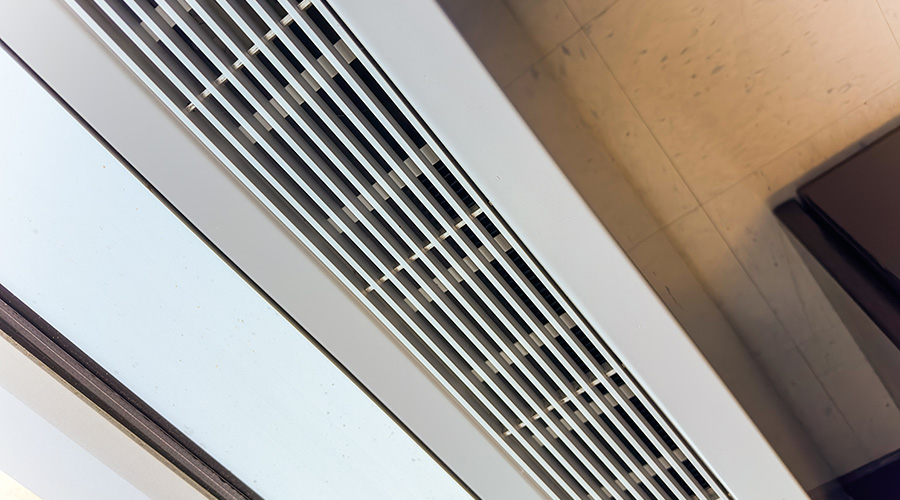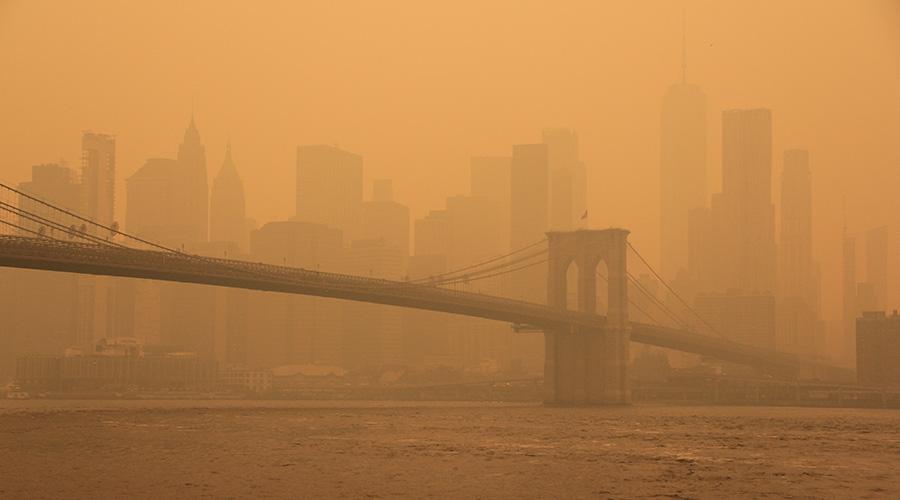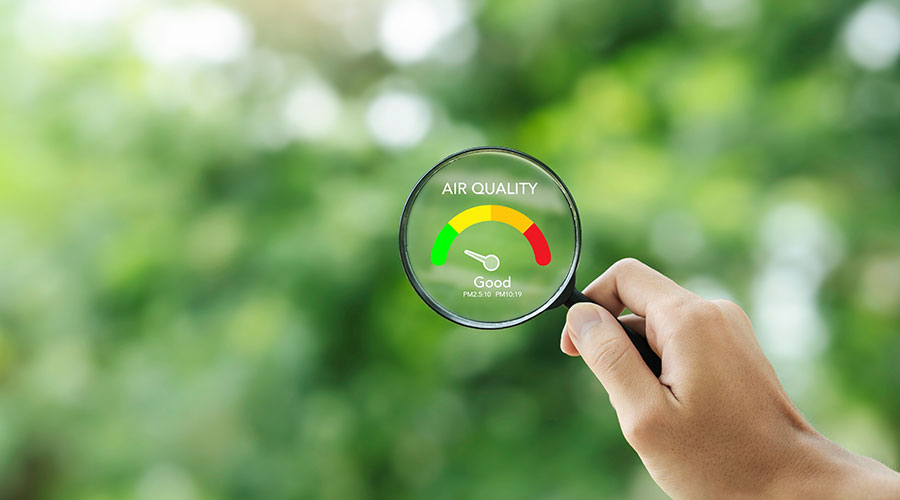Clearing the Air On Filtration
A successful air filtration program involves identifying airborne contaminants and finding the right technology to remove them
A building’s air filtration system is one of the most important elements in providing occupants with good indoor air quality (IAQ). As the needs of building occupants have evolved, so have the capabilities of the air filtration systems.
Where filtering dust and dirt particles had been the primary task of filtration systems, rising concerns over gaseous, chemical, biological and radiological contaminants have created new demands on air filtration systems. And as new demands are placed on filtration systems, manufacturers and system designers are making use of new technologies to further enhance filter capability.
To make the best use of these new technologies, maintenance and engineering managers first must understanding of the types of airborne contaminants found in their facilities. Since it is impractical to completely eliminate contaminants, managers then must determine the degree to which those contaminants must be removed. Finally, they can select the type of system that best matches the requirements of their application.
Common Contaminants
Historically, air filtration systems were designed to protect building HVAC system components from particulate matter. Without filters, heating and cooling coils would quickly become plugged.
Today, concerns over IAQ have changed the role that filters are expected to play in facilities. Now, they are a key element in protecting occupants from particulates, microorganisms, gaseous contaminants and vaporous contaminants.
Particulate contaminants can originate both from within a building and from air drawn into a building by the HVAC systems. Contaminants vary in size, depending on the particular contaminant. Dust and dirt particles generally range from as small as 10 microns to as small as several thousand microns. Smoke and mists range from 0.01-10 microns. Bacterial and other microorganisms are generally 0.1-10 microns.
Gaseous contaminants come primarily from outside of a building and are introduced through its HVAC system, most as a result of placement of fresh-air intakes too close to roads, dumpsters, loading docks or parking garages. Typical contaminants include ozone, nitrogen oxide, nitrogen dioxide, carbon monoxide and sulfur dioxide. Most of these are smaller than 0.01 microns in diameter.
Most vaporous contaminants are generated within a building as the result of off-gassing from synthetic materials, such as carpet, adhesives, composite materials and building insulation. The most common contaminants include volatile organic compounds and formaldehyde. As with gaseous contaminants, vaporous contaminants generally are less than 0.01 micron in diameter.
Once managers have identified the contaminants are present in their facilities, they can take steps to minimize exposure to those contaminants. In some cases, simple changes in operating practices will dramatically reduce contaminant levels.
In other cases, managers might have to make modifications to building systems to reduce exposure. For example:
- Switching to non-volatile adhesives can reduce the off-gassing from carpet and tile installations.
- Redirecting exhaust flow from kitchens away from building fresh air intakes will limit vaporous contaminants introduced into a building.
- Placing fresh-air intakes well away from loading docks and dumpsters will reduce vaporous contaminant levels.
- Prefiltering street-level fresh air intakes will reduce contaminant levels.
The goal of these efforts is to minimize the impact that known sources of airborne contaminants on a building. It is far more cost effective to eliminate contaminants before they enter a building than to have to filter them once they have gained access.
Filter Efficiency
The next step in an effective air filtering program is to determine acceptable levels within a building. While it would be ideal to remove all airborne contaminants, it is simply not practical. For most office applications, a filtration efficiency of 25-40 percent is generally acceptable. Special applications, such as clean rooms, process areas, and health care facilities, might require filtration efficiencies of 95 percent or higher.
As the efficiency of an air filtration system increases, so does the cost of operating and maintaining the system. Therefore, managers must match filtration efficiencies to the needs of the application.
ASHRAE Standard 52.2-1999, Method of Testing General Ventilation Air Cleaning Devices for Removal Efficiencies by Particle Size, establishes minimum air filtration efficiencies. Managers can use the standard to help select the most appropriate type of filter, based on the size and concentration of the contaminants found in their facilities.
Filtration Selection
Buildings today use four basic types of air filtration systems:
- filter media
- electrostatic precipitators
- gas absorbers
- ultraviolet lights.
By far, the most widely used type of filtration system is the filter media. Filter media is available in a number of different configurations, including flat panels, pleated panels and bags. As air passes through the filter media, the filter media fibers trap contaminants. Flat-panel filters offer the lowest pressure drop but have the lowest efficiency — typically, less than 25 percent. Pleated panel filters offer moderate improvements in filtration efficiencies without increasing the pressure drop across the filter. Bag filters offer even higher efficiencies while minimizing pressure drops, but they require a significantly larger space for installation.
Most filter media systems can trap particles down to 1 micron. HEPA filters can trap particles as small as 0.1 microns while providing an efficiency rating of 90-99 percent.
Electrostatic precipitators apply an electrical charge to elements in the filtration system. The charge attracts particles to the elements, where a coating of adhesive holds them in place. Electrostatic precipitators offer the advantages of low pressure drops while providing medium to high operating efficiencies. Most can filter out particles as small as 0.01 microns, including smoke particles.
Gas absorbers are best suited for applications where odors and inorganic materials including volatile organic compounds (VOCs) and ozone are present. Gas absorbers are classified based on operation, physical absorption and chemisorption. Physical absorption units operate by attracting the contaminant molecules to a surface and holding them in place by weak forces.
Chemisorption units attract contaminant molecules to a surface, where they react, forming a chemical bond. The most common types use carbon or charcoal canisters installed in racks within the air stream. Canisters can be disposable or reusable. Absorption efficiencies vary with the design of the unit and the contaminant. Vapors and gasses as small as 0.0003 microns can be removed by the systems.
Since gas absorbers are only effective removing vapors and gases, they must be installed along with another type of filtration system to remove particulate contaminants.
In contrast to other filtration systems, ultraviolet (UV) light systems do not filter any contaminants from the air stream. Instead, they act on any microorganisms found in the air stream, including fungi, bacteria and viruses, killing a percentage of them present in the air stream. To be effective, UV filtration systems must fully expose the flow of air in the duct, and the flow must be slow enough to give the light time to act on the microorganisms.
Like gas absorbers, UV light systems do not remove any particulate contaminants, so they are used in conjunction with another type of air filtration system.
Cost Considerations
Finally, when considering air filtration options, managers must factor in system costs. Depending on the type and efficiency of the system installed, there will be large differences in the total cost of system ownership. First costs, as well as those for maintenance, replacement filters, energy, and disposal all must be factored into system considerations. While managers must evaluate ownership costs with respect to the particular application, they can use several rules of thumb to assist is system selection.
First, while the cost of the filter media is significant, it is not as significant as the cost of labor and system energy operating costs. Add in the cost of cheap, inefficient filters in terms of dirty ducts and coils and poor IAQ, and it makes sense for managers to specify the highest quality filter necessary for their application.
Second, large filter areas are more cost effective than smaller ones. Large filter areas mean lower pressure drops and greater contaminant-holding capacity. Lower pressure drops reduce fan energy requirements, and greater contaminant-holding capacity means fewer filter changes.
Third, the higher the system efficiency, the smaller the particles the system can remove. But higher efficiency also means greater pressure drop in the system and higher fan energy costs. Managers must carefully balance these two factors — system efficiency and pressure drop — based on the particular needs of the application.
Fourth, disposal costs can represent significant operating costs for filtration systems, particularly if any of the contaminants are hazardous materials. Failure to factor in disposal costs when considering different filtration systems can result in high system operating costs.
Finally, all air filtration systems require ongoing maintenance if they are to remain effective. Managers need to carefully review the maintenance cost of any system being considered.
James Piper is a national consultant based in Bowie, Md., with more than 25 years of experience in facilities maintenance management issues.
Related Topics:











